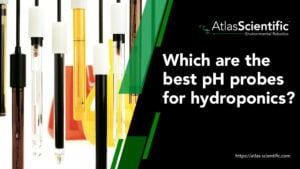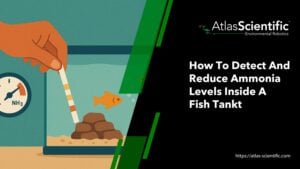

Best pH Probes For Hydroponics in 2025 – A Complete Buying Guide
Finding the best pH probe for hydroponics can make or break your growing success. In hydroponics, maintaining the correct pH is essential because it directly
# Type at least 1 character to search # Hit enter to search or ESC to close

No products in the cart.

No products in the cart.
Product Categories

The Winkler titration method measures the amount of dissolved oxygen in water. It involves adding chemicals to the water to react with the oxygen molecules, to form an acidic solution. The amount of neutralizing agent required to neutralize the solution until the sample becomes clear in color, indicates how much oxygen was in the original water sample.
Measuring dissolved oxygen in addition to conductivity and salinity is a crucial assessment of water quality. As dissolved oxygen measurements vary with depth, time, distance, and temperature, multiple samples and measurements are often required to assess which environmental management is best.
Dissolved oxygen (DO) can be measured using an electrochemical DO meter and probe or using the Winkler method (iodine/thiosulfate titration). The Winkler titration method is the most popular because of its reliable measurement in water samples.

The Winkler titration method for dissolved oxygen is likely something you learned back in chemistry class. It was a method designed by Lajos Winkler, a Hungarian analytical chemist, back in 1888.
Measuring DO using the Winkler method is a highly accurate way to measure water chemistry, providing us with how much oxygen is in a water body to support aquatic habitats and an indication of water pollution.

Despite more modern automated methods available to measure DO in water, the Winkler titration method is extremely accurate, that it is commonly used to check the function of DO probes. The Winkler method is best performed on-site, as delays between collecting the water sample and laboratory testing can alter the amount of oxygen in the water.
The Winkler method is a simple way to manually determine dissolved oxygen in a water sample. Despite its simple methodology, the Winkler method should be performed in the field to avoid delays which could alter the oxygen content of the sample being tested. The sample mustn’t be exposed to oxygen until it has been fixed with a chemical.
Water is collected in a stoppered bottle to prevent oxygen from entering or escaping. Let’s use a 300 ml water sample as an example:

Using a 300 ml sample bottle, 300 ml of the water being analyzed is added and sealed. With a calibrated pipette, 2 ml of manganese sulfate and 2 ml of alkali-iodide-azide are added to the sample bottle. The pipette must be placed just below the water’s surface to avoid bubbles entering the sample.
The sample bottle is then closed with a stopper to avoid external air becoming trapped. The sample bottle is then inverted a few times.
After inverting the bottle, if any bubbles are seen in the water, it must be discarded, and a new water sample needs to be collected. If the water contains oxygen, an orange-brown precipitate will be visible in the sample. Once the precipitate has settled, the sample bottle is inverted again and left to settle, once again.
Using a calibrated probe, 2 ml of concentrated sulfuric acid is added to the water, just above the water’s surface. The stopper is then placed back onto the sample bottle and inverted several times to allow the sulfuric acid to dissolve the precipitate. At this stage, the water is now fixed, as it has successfully reacted with the chemicals above.
The next step is to start the titration process to neutralize the acid. Using a new flask, 201 ml of the treated water sample is titrated with sodium thiosulfate (alkali) until the water turns a pale yellow color.
Next, 2 ml of a starch solution (indicator) is added, initially turning the sample blue.
Finally, the neutralizing agent is added using a burette, ensuring the burette tip is centered and not touching the sides of the beaker.
The neutralizing solution must be added very slowly, drop by drop, and slowly mixed into the sample by gently swirling the beaker or using a magnetic stir plate, ensuring no bubbles form. When the water sample turns from blue to clear, the endpoint has been met, and the titration is stopped.
The amount of neutralizing agent added is directly proportional to the amount of dissolved oxygen in the original water sample. Each ml of neutralizing agent added to the sample equals 1 mg/L of dissolved oxygen. For example, if 5 ml of the neutralizing agent was added to the water sample, the amount of dissolved oxygen would be 5 mg/L.
Studying the oxygen content in water is of great importance in providing information about aquatic ecosystems. Using the Winkler method to measure the amount of dissolved oxygen in water can be used to determine the following:

The Winkler method for dissolved oxygen (DO) is a standard titration technique to measure the oxygen content in water.
Water is collected in a sample bottle with no air that could interfere with the DO reading. Fixed reagents are added to the sample to form an acidic compound. The sample is then neutralized using a neutralizing compound to create a color change. The color change reaches an “endpoint”, turning clear when the water sample is neutralized. The amount of neutralizing agent added to the original sample coincides with the amount of DO in the water.
If you have any questions about dissolved oxygen or what water quality testing kits we have to offer, do not hesitate to contact our world-class team at Atlas Scientific.







Finding the best pH probe for hydroponics can make or break your growing success. In hydroponics, maintaining the correct pH is essential because it directly

The fastest way to reduce ammonia levels in a fish tank is to perform partial water changes, temporarily stop feeding fish, use chemical filtration, increase